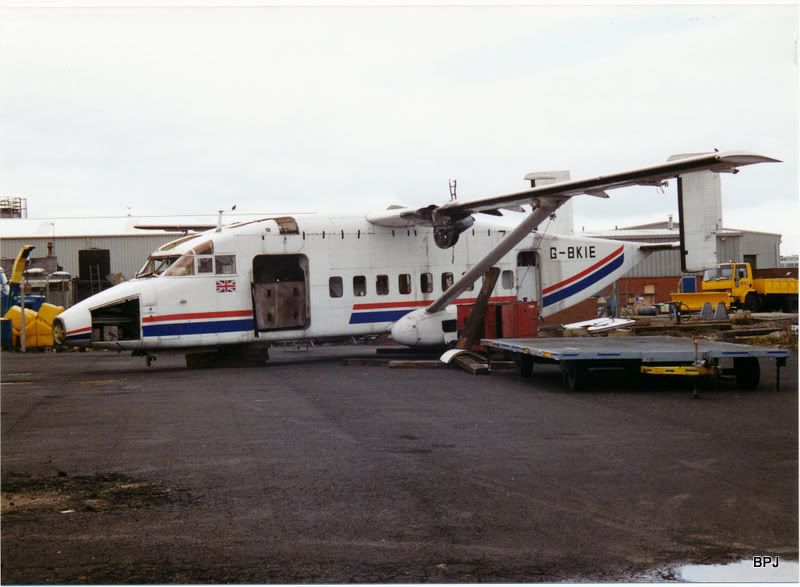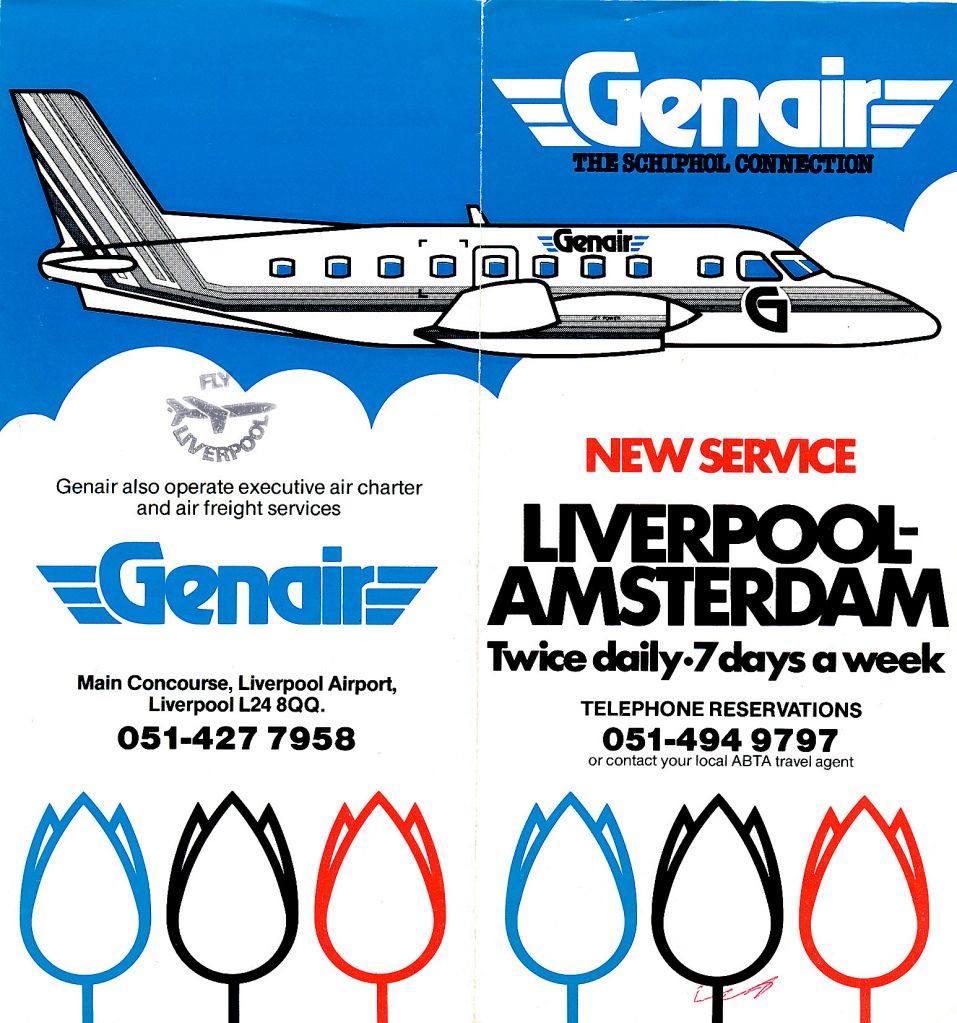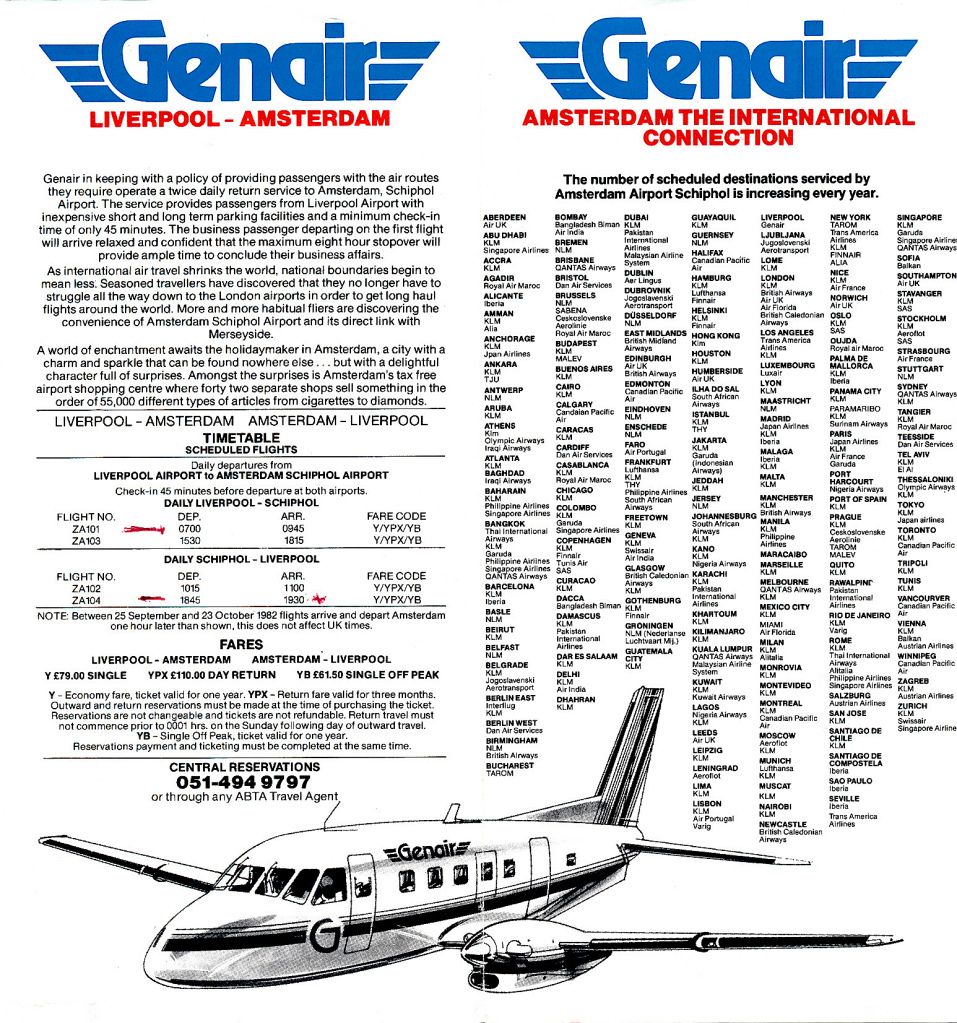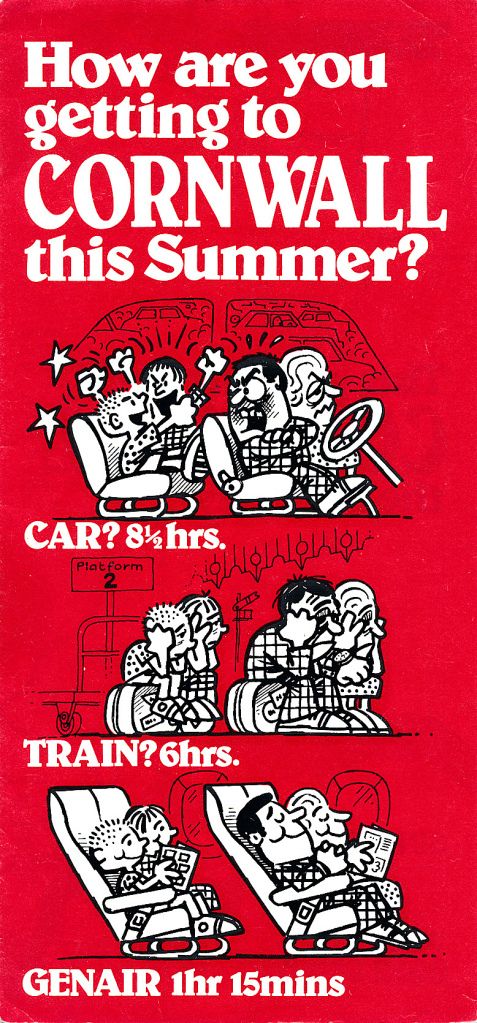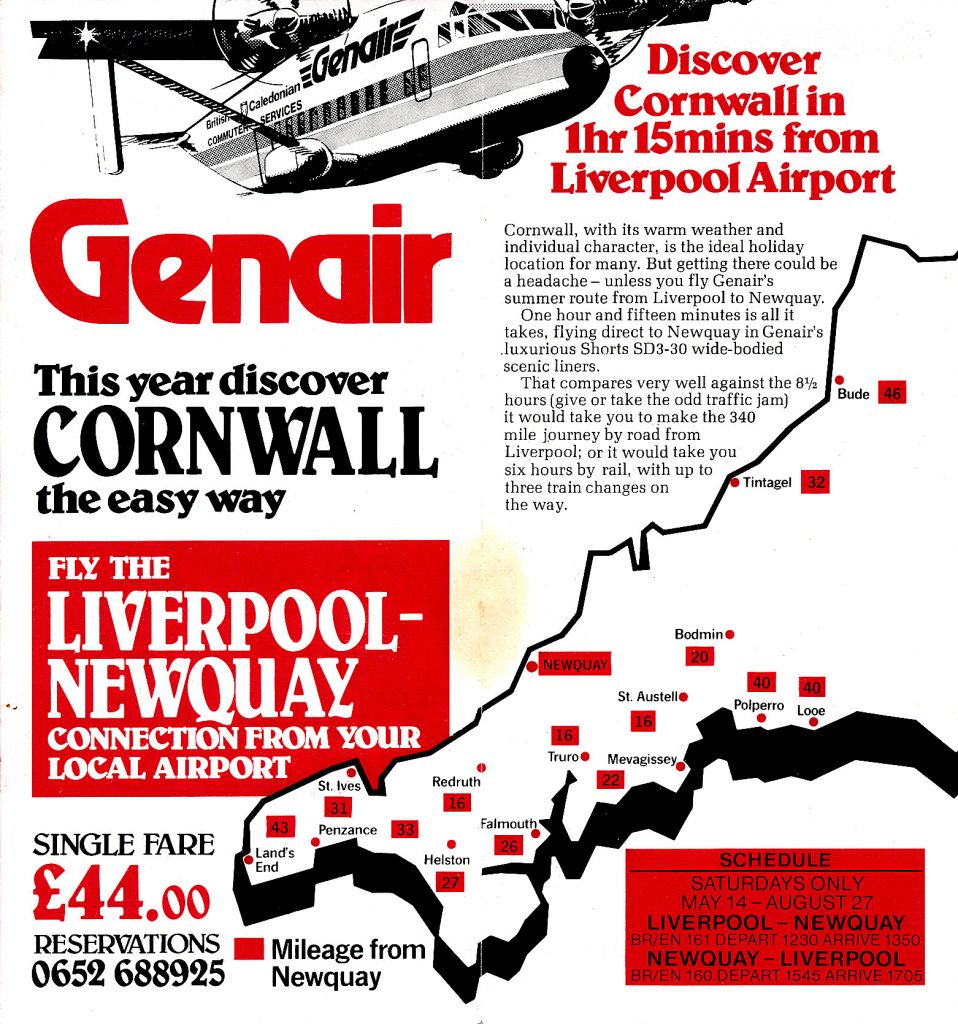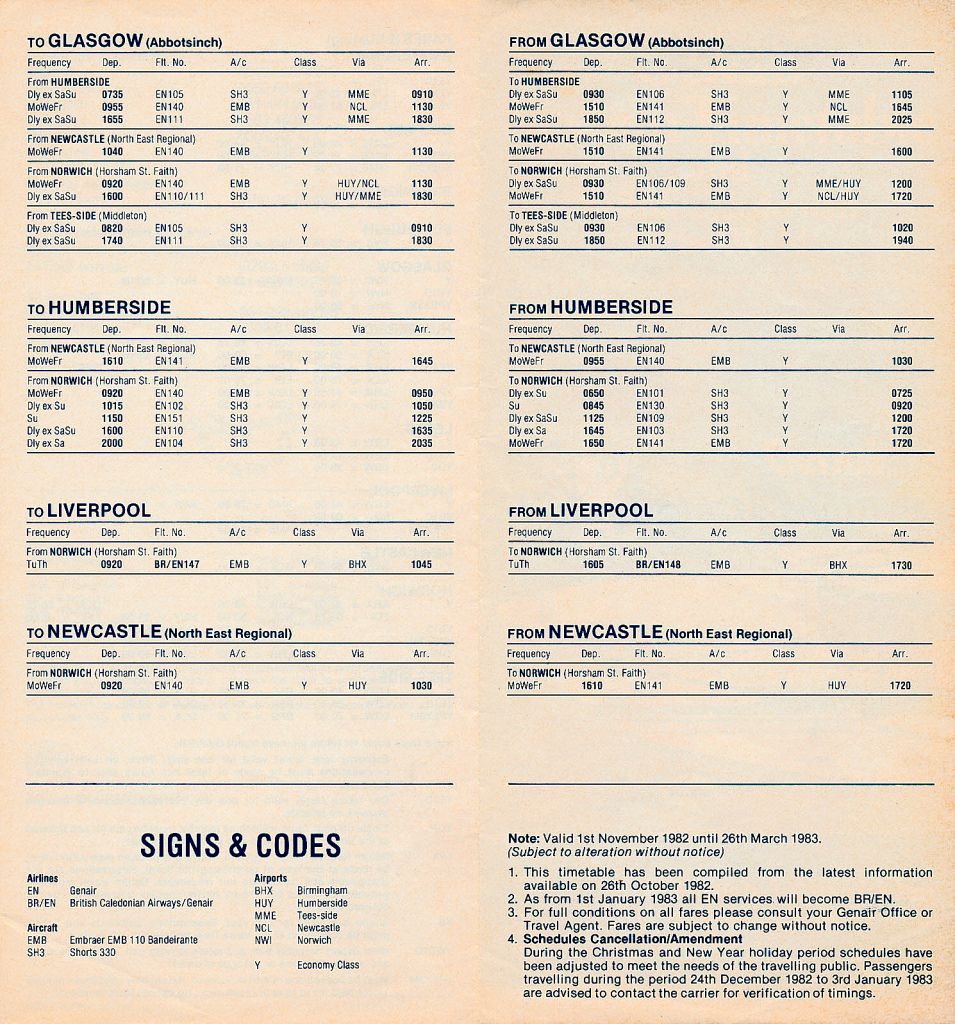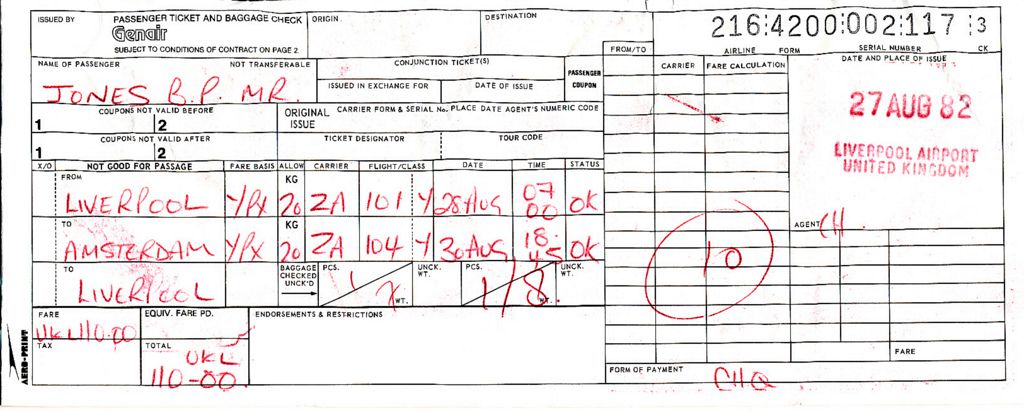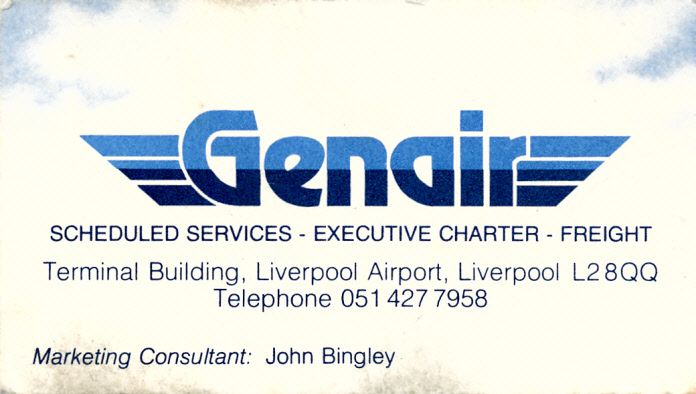Post by viscount on Jun 9, 2010 22:18:28 GMT 1
Genair
A Liverpool Airline 1981-1984
Although I wrote a great deal about the activities of this Airline at the time, I find that I have never written a summative article about this shortlived, but oft recalled airline. So I've had to go back to basics and research from MAS magazines 'EGGP', 'Flypast' and FoLA's '09/27'. Hope you appreciate the work necessary to provide the accurate detail provided, despite the passage of years.
G E N A I R
Genair put their faith in Liverpool Airport at a time when passenger throughput was at its nadir and connected Liverpool to two important destinations in Gatwick and Amsterdam. Ultimately though, Genair, promised much, but once they lost their Liverpool focus delivered little.
Genesis of the Airline
Genair's parent company was General Relays (Crewe) Ltd., providing telecommunications equipment for UK, Eire and beyond. They had factories at Sealand Road, Chester, employing 250 and at Crewe 50-60 emplyees.
In November 1980 the step was taken to invest in a company aircraft, which would also be offered for executive charter when not required. Thinking up the all-important name took some thought, with 'Sealand Air' being the front rummer for some time. Their first aircraft was the former British Steel Beech King Air E90, G-GBSC, acquired via Eagle Aviation at Leavesden. Initially based at Manchester, with Capt. Hugh Jones of General Relays and a pilot on a short term contract from Eagle as crew. The King Air was employed on a regular run from Manchester to Dublin and onto Cork, with an occasional trip down to Spain. Being a bigger airport Manchester seemed the logical base, despite estabished competition in the executive charter market.
Capt. Hugh Jones was charged with looking deeply into the potential of Genair to expand. It did not take long to realise that Manchester was not the ideal home. There was great competition not only with the likes of NEA, but for facilities between GA and the big airlines. Hugh Jones, who had learned to fly at Liverpool, knew there was hangarage and that the Airport was working well below potential, therefore 'hungry' for any expansion possibilities. It was also clear that the executive market was pretty well saturated, however the 'regional' or 'third level' airline sector was showing significant growth. By moving to Liverpool they could provide a service by developing new markets, rather than competing with the establishment.
On 11th February 1981 King Air E90 G-GBSC arrived at Liverpool. Liverpool offered greater scope, and the Airport management were very helpful and their market research pointed Genair towards potential vacant routes.
Building up to becoming an Airline
The next step was to consider investment in airliner equipment. Here a little good timing found CSE Aviation with their demonstrator up for sale. 18 seater, EMB-110P2 Bandeirante G-BHYT, came to Liverpool on demonstration on 9th & 10th April, with delivery in Genair titles on 9th June 1981. The aircraft only had 47 hours of test and delivery flying, plus 42 hours of demonstration work.
While the CAA became satisfied of Genair's ability to operate scheduled services, the new airline found that the market for an 18 seater at Liverpool was boyant. One niche exploited throughout the years were 'Flying Classroom' flights, many operated on behalf of brokers Strata Aviation for local schools, usually using the 18-seater Bandeirante, but also in summer 1983 the Short SD.3-30. Other charters from Liverpool included viewing the 'Blackpool Lights' from the air eg October 1983 and Air Show appearances eg Bandeirante G-RLAY at Duxford 13th June 1982 and Short SD.3-30 G-NICE at Blackpool Satruday 4th June 1983.
Genair started with a realistic policy of no undercutting the opposition. They knew that quality, reliability and availability would sell the airline. It also became clear that if the CAA were to award Genair a scheduled route licence then another aircraft would be needed as back-up and for ad hoc charter. This second aircraft was acquired via Fairflight having previously operated in Saudi - a fact evident from the sand that showered from the air conditioning when first switched on! G-BGCS arrived at Liverpool on 16th July. With two 'Bandits' on-line and the King Air, the necessary CAA authorities in place, Genair were ready to inaugerate scheduled services.
Inauguration of Scheduled Services
On the 3rd August 1981 a twice daily Liverpool-London/Gatwick-Liverpool was inaugurated. The company established a good relationship with British Caledonian at Gatwick, who encouraged Genair as a 'feeder' for its long-haul services. With average load factors increasing, the service become 3 times daily from 26th October. By this time Genair had 21 pilots 'on the books'.
Winter 1981/1982
To permit expansion in the summer, there were changes to fleet during the winter season. Two brand new Bandeirantes were purchased direct from Embraer in Brazil. The first, G-RLAY, was collected from San Jose dos Compos and flown to Liverpool by Hugh Jones and Ron Hammond. They arrived on 27th October 1981. G-RVIP followed, arriving on 12th March 1982. Bandeirante G-BGCS was leased to Air Commuter from the very end of April for use on their Coventry to Paris schedule. The colour scheme was altered with 'AC' on the nose, replacing the 'G' and later 'Air Commuter' name added to the tail, although the Genair cabin titles were retained. This lease appears to have ended at the end of December 1982.
Although not usually part of the Airline operation, the executive King Air G-GBSC was sold in the USA and left Liverpool as N555GA on 11th December 1981. Its place as a General Relays company aircraft was taken by Cessna 421 G-NAIR, which arrived at Liverpool in full Genair scheme on 23rd June 1982. However on 12th October 1982 the aircraft was moved out of Liverpool, most likely due to the closure of the company offices at the airport, but is thought to have continued with General Relays probably until mid 1983.
Summer schedules, 1982
With the winter behind them, the Gatwick route now on the way to becoming established and two extra aircraft, thoughts turn to Summer 1982. From late April the daily weekday flights to Gatwick were increased to four to make better connections, with four return flights on Saturday and three on Sunday. However some rotations did not operate, and on Monday 5th June the schedule was trimmed to 3 flights daily, Monday to Friday, 1 on Saturday and 2 returns on Sunday, with all flights now operating without day by day adjustment to schedules.
A Liverpool to Amsterdam connection was much encouraged by Liverpool Airport management and the Chamber of Commerce. To compete against the jet services from Manchester, Genair had to offer something extra on their unpressurised turbo-props. A Bandeirante was fitted with 15 'armchair' seats and cabin service presented on monogrammed bone-china, with the VIP lounge at Liverpool Airport offered to all passengers. The route was marketed under the slogan "All our passengers are VIPs". On Sunday 4th April, a special inaugral flight operated for invited guests, the first regular revenue earning flights on Monday 5th April 1982. G-BHYT was the aircraft used on most Amsterdam rotations.
The non-pressurised Bandeirante was not the ideal aircraft for a longer sector flight, even with only 15 seats. BAe demonstrated Jetstream 31 G-TALL to Genair at Liverpool on Monday 9th August 1982, 1355-1715, including a 45 minute local, the Jetstream 31 arrived from Manchester and departed to Luton.
A new venture was a summer season Liverpool to Newquay service, twice a week on Friday and Saturday early afternoons, which commenced on May 1st and finished on Friday 10th September 1982.
Fares nearly thirty years ago, are interesting to compare with those of today - although the fare structure and conditions are quite different and are inclusive of VAT, other taxes, luggage and in-flight service! Liverpool to Amsterdam single £79, single off-peak £61.50, return £158, Advance Purchase return (YPX) £110. To Gatwick single £42, single off-peak £35, return £84, same day return (YE1D) £69.50. To Newquay single £39.50, return £79.
Encouraged by British Caledonian a new Bandeirante service was established between Leeds/Bradford and London/Gatwick, which commenced on 5th July at three return flights each weekday and very encouraging advance bookings. The Genair Gatwick operation being marketed under the slogan "Leeds and Liverpool to Gatwick - BCal to the world". Initially operated by a Bandeirante, due to loads, from later in July through to late October this service was operated by a Short SD.3-30 leased in from Loganair (usually either G-BGNA or G-BIRN).
This released a Bandeirante which was based at Norwich from Monday 26th August to operate a weekday night 'Spokes from Speke' mail contract Norwich-Liverpool-Norwich replacing a Lease Air Navajo Chieftain. From Monday 4th October 1982 this contract was changed to operate Norwich-EMA-Liverpool-EMA-Norwich and continued without further change right through to mid-July 1984.
Formation of Britain's largest Commuter Airline
In late August 1982 details began to leak out that Genair had merged with Eastern at Humberside and Casair at Teesside. Initially it was thought that the headquarters would be at Liverpool but under the Eastern name, and a new routes would link Liverpool to Norwich, Humberside and Esbjerg.
However during October hard details emerged. General Relays had indeed taken over the entire shareholding of Lease Air Ltd, who traded as Eastern Airways, and had taken over the Casair routes, the new airline would trade as Genair. Only their five Short SD.3-30 aircraft would be used by Genair (Eastern had three with another imminent and Casair the one), both operators smaller twin aircraft were not part of the deal. At the same time much closer links with BCal saw Genair flying in BCal colours under joint British Caledonian Commuter/Genair titles.
The new company though would be based at Humberside. Managing Director responsible for day-to-day operations of the newly enlarged Genair was Bryan Huxford (formerly MD of Eastern), Chairman Jim Marsden, joint MD Bob Marshall, Director Dennis Allen and Company Secretary John Pollock. First task was to determine the winter schedules to be introduced on 25th October 1982.
During Summer 1982 the three airlines had been operating scheduled services linking:
GENAIR:
Liverpool and London/Gatwick
Leeds and London/Gatwick
Liverpool and Amsterdam
Liverpool and Newquay (summer season only)
also night mail contract, Norwich-Liverpool-Norwich operated with a Bandeirante from 26th August 1982.
EASTERN:
Humberside and London/Heathrow
Humberside and Norwich to London/Gatwick
Humberside and Edinburgh
Humberside and Glasgow
also night mail contracts, including Stansted-Liverpool-Gatwick operated with a Short 3-30 operated since 18th January 1982.
CASAIR:
Teesside and London/Gatwick
Teesside and Glasgow
Teesside and Belfast
Teesside and Guernsey (summer season only)
Teesside and Isle of Man (summer season only)
Operational background of Eastern
Eastern Airways's origins date back to April 1972 when they commenced operations with flying training on a single engined Cessna aircraft. Twin-engined aircraft were acquired the following year for air taxi work. Over the years a fleet of twin-engined Piper Aztec and Navajo aircraft was built up. During July 1978 major expansion occured with the purchase of 3 DC-3 Dakota aircraft for passenger and freight charter work. A major change in direction resulted in an entry into scheduled services when, during April 1981 a route from Humberside to Heathrow was started with either Navajo or Dakota aircraft. In late 1981 the 3 Dakotas were sold to Air Atlantique, having been replaced by 2 Short SD.3-30 aircraft. During 1983 as the network of scheduled routes from Humberside and Norwich was expanded, so two further aircraft were purchased from Time Air in Canada.
Operational background of Casair
Casair of Teesside commenced operations in 1972 with a twin engined aircraft for air taxi work and single engined Cessnas for training. Gradual expansion added to the Air Taxi fleet over the years. Entry into the scheduled air service field occured at first with the use of Cessna 404 Titan aircraft on Air UK routes, as these smaller aircraft were more economical than Air UK's own larger equipment. In 1982 Casair took-over several routes into Teesside and acquired a new Short 3-30 for use alongside the Cessna 404s.
Winter 1982/1983
Use of Genair's IATA and ICAO codes ZA and GEN ceased 31st October, replaced by Eastern Aiways EN. From this point onwards, I'll concentrate on Genair at Liverpool and overlook route development refinements across the rest of the network and the main new route Humberside to Esbjerg.
The winter timetable brought big changes to the operations from Liverpool, mostly positive, but some a step backwards. While London/Gatwick was down from thrice to twice daily on Sunday to Friday and just once on a Saturday, the equipment was uprated to a Short SD.3-30 (although the Bandeirante continued for a week pending delivery of a new aircraft). Short SD.3-30 G-BKIE commenced service from 5th November on the route. From 3rd January 1983 the evening Gatwick inbound service operated via Leeds/Bradford.
The Amsterdam route, which had been building nicely over the summer, was reduced to once daily, Sunday to Friday, in late afternoon - a move and timing that brought protest from Merseyside business. However it soon became clear that the new management team over in Humberside did not feel the route fitted into their vision for the new Genair, as gradually further days were cut, until in March only three flights operated during the entire month, the final one being on Friday 25th March.
New though, was a twice weekly Norwich via Birmingham to Liverpool service on Tuesday and Thursday arriving Liverpool 1045 and leaving 1605.
Fleet developments, winter 82/83
For the early part of the winter, the former Eastern SD.3-30s G-EASI, G-NICE and G-BKDO continued in Eastern titles and red/blue cheatline scheme, while Casair's G-OCAS likewise wore Casair titles and not disimilar scheme. Ex Canadian SD.3-30 G-BKIE which entered service on 5th November was re-painted directly into a British Caledonian scheme, less the golden lion tail logo. In January 1983 G-NICE, G-EASI and G-BKDO were re-sprayed and during February G-OCAS became the last to appear in blue and gold. All five wearing both British Caledonian Commuter and Genair titles. In March '83 G-NICE was the first '3-30 to acquire a Union Jack flag on the all blue tail. A new aircraft was delivered in December 1982 in the form of Short 360 G-BKKT, which entered service in mid January after a period of crew training.
Two of the Bandeirantes were advertised as available for sale in Flight International - however there were no purchasers, so the fleet remained at four. One was out on lease to Air Commuter until December, while another, mainly G-RLAY, was leased to Manx Airlines (in their titles) from 1st November '82 until 26th March '83. One based at Norwich (for night mail and daytime schedules), the other at Liverpool (used on a morning IoM rotation for Manx and Genair's own afternoon Amsterdam service).
Summer 1983 into Winter 1983/1984
In addition to the Amsterdam, further cuts saw the Newquay service (expected to operate 14th May to 27th August) cancelled. The Norwich via Birmingham, on which an increase to 3 times weekly was anticipated from 27th March, continued twice weekly until also withdrawn, last operated on 21st April by G-BHYT.
While the Gatwick service frquencies changed little, with twice daily Monday to Friday, once and Saturdays and Sundays, all by SD.3-30, the big change was that the morning rotation operated via Coventry both ways and the evening rotation operated outbound via Coventry, inbound via Leeds from 5th April. The result was less than ideal times for the Liverpool passengers. However on 15th August the Coventry stops were cut out, although the Leeds stop was retained. As a result services were retimed. From 26th September all services were direct to and from London/Gatwick, but from 28th September all flights were downgraded to a Bandeirante. Further downgrading from 15th October saw the Saturday and Sunday rotation withdrawn.
From early March '83 a new night-time operation, six nights per week, taking newspapers from Manchester to Leuchars (for Edinburgh) often used the Liverpool based SD.3-30 aircraft, or for periods a Manchester day-stopping Bandeirante. Continued until at least 24th March 1984.
In April the Bandeirantes lost their Genair titles, however in June G-BHYT appeared in full blue/gold BCal Commuter colours, followed later in the year by G-BGCS. However G-BGCS's service with Genair came to an unexpected end on 15th November 1983 when the undercarriage folded-up at Norwich. After repair, the aircraft was sold in Canada, departing April 1984. An addition to fleet during the winter was a second brand new Short 360 G-BKZR, arriving on 15th December 1983.
Summer schedules, 1984
The summer timetable returned a Short SD.3-30 to the Liverpool-Gatwick schedule. However the service from 26th March now originated and terminated at Blackpool, with the aircraft night-stopping there. On weekdays with Gatwick departures at 0730 and 1615 and from Gatwick arrivals at 1055 and 1950 were not ideal, but with combined Blackpool and Liverpool passengers combined, the load factors were reasonable. Weekend services were restored, with a single morning return rotation on both Saturday and Sunday.
The sudden end
The rumour spread on Friday 13th July 1984 that Genair had been placed into receivership. This was soon confirmed when Bandeirante G-RLAY was impounded briefly at Liverpool Airport.
The day before SD.3-30 G-BKIE operated the morning EN109/110 rotation, however was unusually substituted with a Bandeirante G-RLAY on the evening EN111/112 rotation. On the Friday morning G-RLAY operated the Blackpool-Liverpool-Gatwick-Liverpool sectors before being impounded at Liverpool. It was released late afternoon and positioned to Teesside.
The last 'Spokes from Speke' mail flights had operated overnight Thursday into Friday. Bandeirante G-RLAY (which must have positioned Blackpool to Norwich) operated the Norwich via EMA mail flight, while SD.3-30 G-EASI operated the Stansted-Liverpool-Gatwick route.
From Monday 16th July Air Ecosse replaced Genair on the Stansted-Liverpool-Gatwick mail flight, using a SD.3-30. On the Norwich & EMA mail, Olsencrest used their Bandeirante G-BKWS for a week, then Topflight took on the contract with DH Heron G-ANUO.
After the collapse, many of the fleet were impounded at Humberside, Bandeirantes G-BHYT & G-RVIP, SD.3-30s G-BKDO & G-EASI, SD.360 G-BKKT, with SD.360 G-BKZR at Leeds and Bandeirante G-RLAY and SD.3-30 G-NICE at Teesside.
All the BCal Commuter affiliated airlines and others applied for the Liverpool to Gatwick scheduled licence. Guernsey Airlines, Jersey European Airways (JEA), Spacegrand, Brymon, Air Ecosse, Fairflight and Manx Airlines all applied, but by September all seven had withdrawn their intent to operate on the route.
There was much printed in the newspapers at the time, the blame on the airline's collapse being placed on two Directors having embezelled several millions of Pounds and disappearing in Canada. I don't recall any subsequent extradition and court cases though, to put closure on the company failure. Clearly though the failure can be put down to financial mis-management.
Whatever the cause, a sad end to an airline that promised much, but ultimately delivered little apart from memories and might have beens.
......Well that is the Genair story completed .. do you have any personal memories or photos to share...
A Liverpool Airline 1981-1984
Although I wrote a great deal about the activities of this Airline at the time, I find that I have never written a summative article about this shortlived, but oft recalled airline. So I've had to go back to basics and research from MAS magazines 'EGGP', 'Flypast' and FoLA's '09/27'. Hope you appreciate the work necessary to provide the accurate detail provided, despite the passage of years.
G E N A I R
Genair put their faith in Liverpool Airport at a time when passenger throughput was at its nadir and connected Liverpool to two important destinations in Gatwick and Amsterdam. Ultimately though, Genair, promised much, but once they lost their Liverpool focus delivered little.
Genesis of the Airline
Genair's parent company was General Relays (Crewe) Ltd., providing telecommunications equipment for UK, Eire and beyond. They had factories at Sealand Road, Chester, employing 250 and at Crewe 50-60 emplyees.
In November 1980 the step was taken to invest in a company aircraft, which would also be offered for executive charter when not required. Thinking up the all-important name took some thought, with 'Sealand Air' being the front rummer for some time. Their first aircraft was the former British Steel Beech King Air E90, G-GBSC, acquired via Eagle Aviation at Leavesden. Initially based at Manchester, with Capt. Hugh Jones of General Relays and a pilot on a short term contract from Eagle as crew. The King Air was employed on a regular run from Manchester to Dublin and onto Cork, with an occasional trip down to Spain. Being a bigger airport Manchester seemed the logical base, despite estabished competition in the executive charter market.
Capt. Hugh Jones was charged with looking deeply into the potential of Genair to expand. It did not take long to realise that Manchester was not the ideal home. There was great competition not only with the likes of NEA, but for facilities between GA and the big airlines. Hugh Jones, who had learned to fly at Liverpool, knew there was hangarage and that the Airport was working well below potential, therefore 'hungry' for any expansion possibilities. It was also clear that the executive market was pretty well saturated, however the 'regional' or 'third level' airline sector was showing significant growth. By moving to Liverpool they could provide a service by developing new markets, rather than competing with the establishment.
On 11th February 1981 King Air E90 G-GBSC arrived at Liverpool. Liverpool offered greater scope, and the Airport management were very helpful and their market research pointed Genair towards potential vacant routes.
Building up to becoming an Airline
The next step was to consider investment in airliner equipment. Here a little good timing found CSE Aviation with their demonstrator up for sale. 18 seater, EMB-110P2 Bandeirante G-BHYT, came to Liverpool on demonstration on 9th & 10th April, with delivery in Genair titles on 9th June 1981. The aircraft only had 47 hours of test and delivery flying, plus 42 hours of demonstration work.
While the CAA became satisfied of Genair's ability to operate scheduled services, the new airline found that the market for an 18 seater at Liverpool was boyant. One niche exploited throughout the years were 'Flying Classroom' flights, many operated on behalf of brokers Strata Aviation for local schools, usually using the 18-seater Bandeirante, but also in summer 1983 the Short SD.3-30. Other charters from Liverpool included viewing the 'Blackpool Lights' from the air eg October 1983 and Air Show appearances eg Bandeirante G-RLAY at Duxford 13th June 1982 and Short SD.3-30 G-NICE at Blackpool Satruday 4th June 1983.
Genair started with a realistic policy of no undercutting the opposition. They knew that quality, reliability and availability would sell the airline. It also became clear that if the CAA were to award Genair a scheduled route licence then another aircraft would be needed as back-up and for ad hoc charter. This second aircraft was acquired via Fairflight having previously operated in Saudi - a fact evident from the sand that showered from the air conditioning when first switched on! G-BGCS arrived at Liverpool on 16th July. With two 'Bandits' on-line and the King Air, the necessary CAA authorities in place, Genair were ready to inaugerate scheduled services.
Inauguration of Scheduled Services
On the 3rd August 1981 a twice daily Liverpool-London/Gatwick-Liverpool was inaugurated. The company established a good relationship with British Caledonian at Gatwick, who encouraged Genair as a 'feeder' for its long-haul services. With average load factors increasing, the service become 3 times daily from 26th October. By this time Genair had 21 pilots 'on the books'.
Winter 1981/1982
To permit expansion in the summer, there were changes to fleet during the winter season. Two brand new Bandeirantes were purchased direct from Embraer in Brazil. The first, G-RLAY, was collected from San Jose dos Compos and flown to Liverpool by Hugh Jones and Ron Hammond. They arrived on 27th October 1981. G-RVIP followed, arriving on 12th March 1982. Bandeirante G-BGCS was leased to Air Commuter from the very end of April for use on their Coventry to Paris schedule. The colour scheme was altered with 'AC' on the nose, replacing the 'G' and later 'Air Commuter' name added to the tail, although the Genair cabin titles were retained. This lease appears to have ended at the end of December 1982.
Although not usually part of the Airline operation, the executive King Air G-GBSC was sold in the USA and left Liverpool as N555GA on 11th December 1981. Its place as a General Relays company aircraft was taken by Cessna 421 G-NAIR, which arrived at Liverpool in full Genair scheme on 23rd June 1982. However on 12th October 1982 the aircraft was moved out of Liverpool, most likely due to the closure of the company offices at the airport, but is thought to have continued with General Relays probably until mid 1983.
Summer schedules, 1982
With the winter behind them, the Gatwick route now on the way to becoming established and two extra aircraft, thoughts turn to Summer 1982. From late April the daily weekday flights to Gatwick were increased to four to make better connections, with four return flights on Saturday and three on Sunday. However some rotations did not operate, and on Monday 5th June the schedule was trimmed to 3 flights daily, Monday to Friday, 1 on Saturday and 2 returns on Sunday, with all flights now operating without day by day adjustment to schedules.
A Liverpool to Amsterdam connection was much encouraged by Liverpool Airport management and the Chamber of Commerce. To compete against the jet services from Manchester, Genair had to offer something extra on their unpressurised turbo-props. A Bandeirante was fitted with 15 'armchair' seats and cabin service presented on monogrammed bone-china, with the VIP lounge at Liverpool Airport offered to all passengers. The route was marketed under the slogan "All our passengers are VIPs". On Sunday 4th April, a special inaugral flight operated for invited guests, the first regular revenue earning flights on Monday 5th April 1982. G-BHYT was the aircraft used on most Amsterdam rotations.
The non-pressurised Bandeirante was not the ideal aircraft for a longer sector flight, even with only 15 seats. BAe demonstrated Jetstream 31 G-TALL to Genair at Liverpool on Monday 9th August 1982, 1355-1715, including a 45 minute local, the Jetstream 31 arrived from Manchester and departed to Luton.
A new venture was a summer season Liverpool to Newquay service, twice a week on Friday and Saturday early afternoons, which commenced on May 1st and finished on Friday 10th September 1982.
Fares nearly thirty years ago, are interesting to compare with those of today - although the fare structure and conditions are quite different and are inclusive of VAT, other taxes, luggage and in-flight service! Liverpool to Amsterdam single £79, single off-peak £61.50, return £158, Advance Purchase return (YPX) £110. To Gatwick single £42, single off-peak £35, return £84, same day return (YE1D) £69.50. To Newquay single £39.50, return £79.
Encouraged by British Caledonian a new Bandeirante service was established between Leeds/Bradford and London/Gatwick, which commenced on 5th July at three return flights each weekday and very encouraging advance bookings. The Genair Gatwick operation being marketed under the slogan "Leeds and Liverpool to Gatwick - BCal to the world". Initially operated by a Bandeirante, due to loads, from later in July through to late October this service was operated by a Short SD.3-30 leased in from Loganair (usually either G-BGNA or G-BIRN).
This released a Bandeirante which was based at Norwich from Monday 26th August to operate a weekday night 'Spokes from Speke' mail contract Norwich-Liverpool-Norwich replacing a Lease Air Navajo Chieftain. From Monday 4th October 1982 this contract was changed to operate Norwich-EMA-Liverpool-EMA-Norwich and continued without further change right through to mid-July 1984.
Formation of Britain's largest Commuter Airline
In late August 1982 details began to leak out that Genair had merged with Eastern at Humberside and Casair at Teesside. Initially it was thought that the headquarters would be at Liverpool but under the Eastern name, and a new routes would link Liverpool to Norwich, Humberside and Esbjerg.
However during October hard details emerged. General Relays had indeed taken over the entire shareholding of Lease Air Ltd, who traded as Eastern Airways, and had taken over the Casair routes, the new airline would trade as Genair. Only their five Short SD.3-30 aircraft would be used by Genair (Eastern had three with another imminent and Casair the one), both operators smaller twin aircraft were not part of the deal. At the same time much closer links with BCal saw Genair flying in BCal colours under joint British Caledonian Commuter/Genair titles.
The new company though would be based at Humberside. Managing Director responsible for day-to-day operations of the newly enlarged Genair was Bryan Huxford (formerly MD of Eastern), Chairman Jim Marsden, joint MD Bob Marshall, Director Dennis Allen and Company Secretary John Pollock. First task was to determine the winter schedules to be introduced on 25th October 1982.
During Summer 1982 the three airlines had been operating scheduled services linking:
GENAIR:
Liverpool and London/Gatwick
Leeds and London/Gatwick
Liverpool and Amsterdam
Liverpool and Newquay (summer season only)
also night mail contract, Norwich-Liverpool-Norwich operated with a Bandeirante from 26th August 1982.
EASTERN:
Humberside and London/Heathrow
Humberside and Norwich to London/Gatwick
Humberside and Edinburgh
Humberside and Glasgow
also night mail contracts, including Stansted-Liverpool-Gatwick operated with a Short 3-30 operated since 18th January 1982.
CASAIR:
Teesside and London/Gatwick
Teesside and Glasgow
Teesside and Belfast
Teesside and Guernsey (summer season only)
Teesside and Isle of Man (summer season only)
Operational background of Eastern
Eastern Airways's origins date back to April 1972 when they commenced operations with flying training on a single engined Cessna aircraft. Twin-engined aircraft were acquired the following year for air taxi work. Over the years a fleet of twin-engined Piper Aztec and Navajo aircraft was built up. During July 1978 major expansion occured with the purchase of 3 DC-3 Dakota aircraft for passenger and freight charter work. A major change in direction resulted in an entry into scheduled services when, during April 1981 a route from Humberside to Heathrow was started with either Navajo or Dakota aircraft. In late 1981 the 3 Dakotas were sold to Air Atlantique, having been replaced by 2 Short SD.3-30 aircraft. During 1983 as the network of scheduled routes from Humberside and Norwich was expanded, so two further aircraft were purchased from Time Air in Canada.
Operational background of Casair
Casair of Teesside commenced operations in 1972 with a twin engined aircraft for air taxi work and single engined Cessnas for training. Gradual expansion added to the Air Taxi fleet over the years. Entry into the scheduled air service field occured at first with the use of Cessna 404 Titan aircraft on Air UK routes, as these smaller aircraft were more economical than Air UK's own larger equipment. In 1982 Casair took-over several routes into Teesside and acquired a new Short 3-30 for use alongside the Cessna 404s.
Winter 1982/1983
Use of Genair's IATA and ICAO codes ZA and GEN ceased 31st October, replaced by Eastern Aiways EN. From this point onwards, I'll concentrate on Genair at Liverpool and overlook route development refinements across the rest of the network and the main new route Humberside to Esbjerg.
The winter timetable brought big changes to the operations from Liverpool, mostly positive, but some a step backwards. While London/Gatwick was down from thrice to twice daily on Sunday to Friday and just once on a Saturday, the equipment was uprated to a Short SD.3-30 (although the Bandeirante continued for a week pending delivery of a new aircraft). Short SD.3-30 G-BKIE commenced service from 5th November on the route. From 3rd January 1983 the evening Gatwick inbound service operated via Leeds/Bradford.
The Amsterdam route, which had been building nicely over the summer, was reduced to once daily, Sunday to Friday, in late afternoon - a move and timing that brought protest from Merseyside business. However it soon became clear that the new management team over in Humberside did not feel the route fitted into their vision for the new Genair, as gradually further days were cut, until in March only three flights operated during the entire month, the final one being on Friday 25th March.
New though, was a twice weekly Norwich via Birmingham to Liverpool service on Tuesday and Thursday arriving Liverpool 1045 and leaving 1605.
Fleet developments, winter 82/83
For the early part of the winter, the former Eastern SD.3-30s G-EASI, G-NICE and G-BKDO continued in Eastern titles and red/blue cheatline scheme, while Casair's G-OCAS likewise wore Casair titles and not disimilar scheme. Ex Canadian SD.3-30 G-BKIE which entered service on 5th November was re-painted directly into a British Caledonian scheme, less the golden lion tail logo. In January 1983 G-NICE, G-EASI and G-BKDO were re-sprayed and during February G-OCAS became the last to appear in blue and gold. All five wearing both British Caledonian Commuter and Genair titles. In March '83 G-NICE was the first '3-30 to acquire a Union Jack flag on the all blue tail. A new aircraft was delivered in December 1982 in the form of Short 360 G-BKKT, which entered service in mid January after a period of crew training.
Two of the Bandeirantes were advertised as available for sale in Flight International - however there were no purchasers, so the fleet remained at four. One was out on lease to Air Commuter until December, while another, mainly G-RLAY, was leased to Manx Airlines (in their titles) from 1st November '82 until 26th March '83. One based at Norwich (for night mail and daytime schedules), the other at Liverpool (used on a morning IoM rotation for Manx and Genair's own afternoon Amsterdam service).
Summer 1983 into Winter 1983/1984
In addition to the Amsterdam, further cuts saw the Newquay service (expected to operate 14th May to 27th August) cancelled. The Norwich via Birmingham, on which an increase to 3 times weekly was anticipated from 27th March, continued twice weekly until also withdrawn, last operated on 21st April by G-BHYT.
While the Gatwick service frquencies changed little, with twice daily Monday to Friday, once and Saturdays and Sundays, all by SD.3-30, the big change was that the morning rotation operated via Coventry both ways and the evening rotation operated outbound via Coventry, inbound via Leeds from 5th April. The result was less than ideal times for the Liverpool passengers. However on 15th August the Coventry stops were cut out, although the Leeds stop was retained. As a result services were retimed. From 26th September all services were direct to and from London/Gatwick, but from 28th September all flights were downgraded to a Bandeirante. Further downgrading from 15th October saw the Saturday and Sunday rotation withdrawn.
From early March '83 a new night-time operation, six nights per week, taking newspapers from Manchester to Leuchars (for Edinburgh) often used the Liverpool based SD.3-30 aircraft, or for periods a Manchester day-stopping Bandeirante. Continued until at least 24th March 1984.
In April the Bandeirantes lost their Genair titles, however in June G-BHYT appeared in full blue/gold BCal Commuter colours, followed later in the year by G-BGCS. However G-BGCS's service with Genair came to an unexpected end on 15th November 1983 when the undercarriage folded-up at Norwich. After repair, the aircraft was sold in Canada, departing April 1984. An addition to fleet during the winter was a second brand new Short 360 G-BKZR, arriving on 15th December 1983.
Summer schedules, 1984
The summer timetable returned a Short SD.3-30 to the Liverpool-Gatwick schedule. However the service from 26th March now originated and terminated at Blackpool, with the aircraft night-stopping there. On weekdays with Gatwick departures at 0730 and 1615 and from Gatwick arrivals at 1055 and 1950 were not ideal, but with combined Blackpool and Liverpool passengers combined, the load factors were reasonable. Weekend services were restored, with a single morning return rotation on both Saturday and Sunday.
The sudden end
The rumour spread on Friday 13th July 1984 that Genair had been placed into receivership. This was soon confirmed when Bandeirante G-RLAY was impounded briefly at Liverpool Airport.
The day before SD.3-30 G-BKIE operated the morning EN109/110 rotation, however was unusually substituted with a Bandeirante G-RLAY on the evening EN111/112 rotation. On the Friday morning G-RLAY operated the Blackpool-Liverpool-Gatwick-Liverpool sectors before being impounded at Liverpool. It was released late afternoon and positioned to Teesside.
The last 'Spokes from Speke' mail flights had operated overnight Thursday into Friday. Bandeirante G-RLAY (which must have positioned Blackpool to Norwich) operated the Norwich via EMA mail flight, while SD.3-30 G-EASI operated the Stansted-Liverpool-Gatwick route.
From Monday 16th July Air Ecosse replaced Genair on the Stansted-Liverpool-Gatwick mail flight, using a SD.3-30. On the Norwich & EMA mail, Olsencrest used their Bandeirante G-BKWS for a week, then Topflight took on the contract with DH Heron G-ANUO.
After the collapse, many of the fleet were impounded at Humberside, Bandeirantes G-BHYT & G-RVIP, SD.3-30s G-BKDO & G-EASI, SD.360 G-BKKT, with SD.360 G-BKZR at Leeds and Bandeirante G-RLAY and SD.3-30 G-NICE at Teesside.
All the BCal Commuter affiliated airlines and others applied for the Liverpool to Gatwick scheduled licence. Guernsey Airlines, Jersey European Airways (JEA), Spacegrand, Brymon, Air Ecosse, Fairflight and Manx Airlines all applied, but by September all seven had withdrawn their intent to operate on the route.
There was much printed in the newspapers at the time, the blame on the airline's collapse being placed on two Directors having embezelled several millions of Pounds and disappearing in Canada. I don't recall any subsequent extradition and court cases though, to put closure on the company failure. Clearly though the failure can be put down to financial mis-management.
Whatever the cause, a sad end to an airline that promised much, but ultimately delivered little apart from memories and might have beens.
......Well that is the Genair story completed .. do you have any personal memories or photos to share...

















